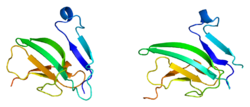| ACVR2A |
|---|
 |
| Estructuras disponibles |
|---|
| PDB | Búsqueda ortóloga: PDBe RCSB |
|---|
| Lista de codigos id de PDB | | 3Q4T, 3SOC, 4ASX | | |
| Identificadores |
|---|
| Alias | ACVR2A, ACTRII, ACVR2, activin A receptor type 2A |
|---|
| IDs externos | OMIM: 102581 MGI: 102806 HomoloGene: 20391 GeneCards: ACVR2A |
|---|
| Ontología génica |
|---|
| Función molecular | • transferase activity
• nucleotide binding
• protein kinase activity
• PDZ domain binding
• growth factor binding
• coreceptor activity
• activin binding
• metal ion binding
• kinase activity
• protein self-association
• protein serine/threonine kinase activity
• transmembrane receptor protein serine/threonine kinase activity
• inhibin binding
• GO:0001948, GO:0016582 unión a proteína plasmática
• activin-activated receptor activity
• ATP binding
• BMP receptor activity
• transforming growth factor beta-activated receptor activity
• transforming growth factor beta receptor activity, type II
• type I transforming growth factor beta receptor binding
• SMAD binding
|
|---|
| Componente celular | • citoplasma
• componente integral de membrana
• inhibin-betaglycan-ActRII complex
• membrana
• receptor complex
• membrana plasmática
• integral component of plasma membrane
• cell surface
• activin receptor complex
|
|---|
| Proceso biológico | • positive regulation of protein phosphorylation
• male gonad development
• eyaculación
• positive regulation of erythrocyte differentiation
• positive regulation of bone mineralization
• fosforilación
• positive regulation of pathway-restricted SMAD protein phosphorylation
• gastrulation with mouth forming second
• erección
• regulation of nitric-oxide synthase activity
• cellular response to BMP stimulus
• Sertoli cell proliferation
• BMP signaling pathway
• embryonic skeletal system development
• regulation of BMP signaling pathway
• fosforilación de proteína
• determination of left/right symmetry
• transmembrane receptor protein serine/threonine kinase signaling pathway
• positive regulation of activin receptor signaling pathway
• positive regulation of osteoblast differentiation
• regulation of signal transduction
• espermatogénesis
• mesoderm development
• anterior/posterior pattern specification
• GO:0003257, GO:0010735, GO:1901228, GO:1900622, GO:1904488 positive regulation of transcription by RNA polymerase II
• activin receptor signaling pathway
• transforming growth factor beta receptor signaling pathway
• proceso de especificación de patrón
|
|---|
| Fuentes: Amigo / QuickGO | |
| Ortólogos |
|---|
| Especies | Humano | Ratón |
|---|
| Entrez | | |
|---|
| Ensembl | | |
|---|
| UniProt | | |
|---|
| SeqRef (ARNm) | | | NM_001278579
NM_001278580
NM_001616 |
| |
|---|
| SeqRef (proteina) | | | NP_001265508
NP_001265509
NP_001607 |
| |
|---|
| Localización (UCSC) | n/a | n/a |
|---|
| Búsqueda en PubMed | [1] | [2] |
|---|
| Wikidata |
| Ver/Editar Humano | Ver/Editar Ratón |
El receptor de activina tipo 2A es una proteína que en humanos está codificada por el gen ACVR2A .[3][4][5] ACVR2A es un receptor de activina tipo 2 .
Función
Este gen codifica el receptor de activina A tipo II. Las activinas son factores diméricos de crecimiento y diferenciación que pertenecen a la superfamilia del factor de crecimiento transformante beta (TGF-beta) de proteínas de señalización relacionadas estructuralmente. Las activinas señalizan a través de un complejo heteromérico de serina quinasas receptoras que incluyen al menos dos receptores de tipo I (I y IB) y dos de tipo II (II y IIB). Todos estos receptores son proteínas transmembrana, compuestas por un dominio extracelular de unión a ligando con región rica en cisteína, un dominio transmembrana y un dominio citoplásmico con especificidad de serina / treonina predicha. Los receptores de tipo I son esenciales para la señalización; y los receptores de tipo II son necesarios para unir ligandos y para la expresión de receptores de tipo I. Los receptores de tipo I y II forman un complejo estable después de la unión del ligando, lo que resulta en la fosforilación de los receptores de tipo I por los receptores de tipo II. Los receptores de tipo II se consideran quinasas constitutivamente activas.[5]
Interacciones
Se ha demostrado que ACVR2A interactúa con:
- ACVR1B,[6][7]
- INHBA,[8][9] y
- SYNJ2BP .[10][11]
Referencias
- ↑ «Human PubMed Reference:».
- ↑ «Mouse PubMed Reference:».
- ↑ «Molecular cloning and binding properties of the human type II activin receptor». Biochem. Biophys. Res. Commun. 184 (1): 310-6. May 1992. PMID 1314589. doi:10.1016/0006-291X(92)91194-U.
- ↑ «Assignment of ACVR2 and ACVR2B the human activin receptor type II and IIB genes to chromosome bands 2q22.2-->q23.3 and 3p22 and the human follistatin gene (FST) to chromosome 5q11.2 by FISH». Cytogenet. Cell Genet. 87 (3–4): 219-20. April 2000. PMID 10702675. doi:10.1159/000015429.
- ↑ a b «Entrez Gene: ACVR2A activin A receptor, type IIA».
- ↑ «Roles of pathway-specific and inhibitory Smads in activin receptor signaling». Mol. Endocrinol. 13 (1): 15-23. January 1999. PMID 9892009. doi:10.1210/mend.13.1.0218.
- ↑ «Truncated activin type II receptors inhibit bioactivity by the formation of heteromeric complexes with activin type I. receptors». Exp. Cell Res. 224 (2): 323-34. May 1996. PMID 8612709. doi:10.1006/excr.1996.0142.
- ↑ «Betaglycan binds inhibin and can mediate functional antagonism of activin signalling». Nature 404 (6776): 411-4. March 2000. Bibcode:2000Natur.404..411L. PMID 10746731. doi:10.1038/35006129.
- ↑ «Inhibin interferes with activin signaling at the level of the activin receptor complex in Chinese hamster ovary cells». Endocrinology 138 (7): 2928-36. July 1997. PMID 9202237. doi:10.1210/endo.138.7.5250.
- ↑ «Novel factors in regulation of activin signaling». Mol. Cell. Endocrinol. 225 (1–2): 1-8. October 2004. PMID 15451561. doi:10.1016/j.mce.2004.02.006.
- ↑ «Regulation of endocytosis of activin type II receptors by a novel PDZ protein through Ral/Ral-binding protein 1-dependent pathway». J. Biol. Chem. 277 (21): 19008-18. May 2002. PMID 11882656. doi:10.1074/jbc.M112472200.
 Datos: Q14905170
Datos: Q14905170

 Datos: Q14905170
Datos: Q14905170








